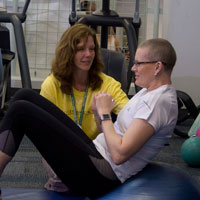By YMCA

What do you think of when you hear the word “cancer”? Like me, you probably don’t think of “working out”, or “increased levels of physical activity”. You might think of hair loss, painful treatments, feeling sick, and having no energy, among other things. But for some folks, exercise and physical activity is just what their doctor orders, even if they haven’t been active in the past. In most cases, the physical activity guidelines can be followed by (or modified for) cancer survivors, especially while under the care of an oncologist or other physician. Physical activity not only helps improve their physical health, but can also be instrumental in improving their overall well-being.
The Y started actively working with cancer survivors in organized programs more than three years ago, and has been instrumental in helping cancer survivors understand the role of physical activity in their life, and increasing their levels of physical activity during all phases of their life as a cancer survivor. (For most, the definition of a cancer survivor is anyone who has been diagnosed with cancer, from the minute of their diagnosis).
How did the Y become more effective in increasing activity levels with cancer survivors? Select Ys participated in the LIVESTRONG at the YMCA collaborative, in partnership with the Lance Armstrong Foundation. First, they oriented and trained their staff. Second, they engaged multiple cancer experts and organizations, locally and nationally. Third, they did everything they could to ease cancer survivors into evidence based programs, lead by caring, empathic staff, in safe comfortable surroundings, with other cancer survivors. And fourth, they shared what they learned along with the way.
Staff throughout these Ys were oriented and trained on how to respond appropriately when someone identifies themselves as a cancer survivor. We also learned basic, factual information about cancer, treatments, and ways to successfully engage cancer survivors in safe levels of physical activity. We involved local and national cancer experts during meetings, webinars, and conference calls, to glean more information about safe physical activities for cancer survivors, like weight training, aerobic activity, and flexibility exercises. This was critical to the creditability of the LiveStrong at the Y program, as was the empathic staff who led group physical activities or one-on-one training with cancer survivors.
One of the more creative and helpful aspects of the LiveStrong at the Y program was helping cancer survivors feel in control of their lives, through physical activity. Instead of feeling like their cancer diagnosis was a signal to do nothing (which can lead to a feeling like cancer is controlling your life), participants were encouraged to and participated in physical activities that showed they could indeed increase their physical conditioning, become stronger, more flexible, which overall showed them their cancer was something they could deal with. Working out with other cancer survivors, and even participating in activities that benefited others (park clean ups, food drives, etc.), only enhanced this feeling of being back and being in control of one’s life.
The physical activity guidelines are important for all people, abilities, and mindsets.
How are you using the guidelines in new programs or in programs with new populations?